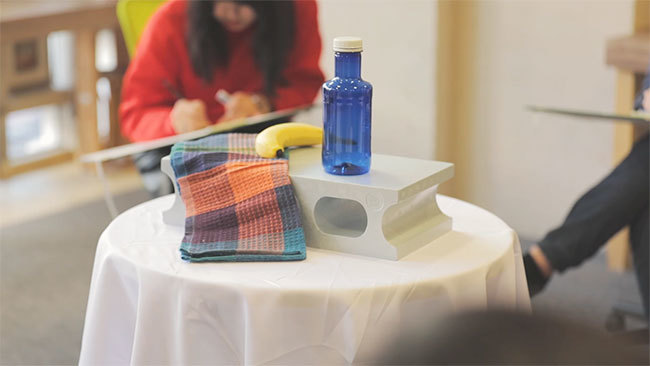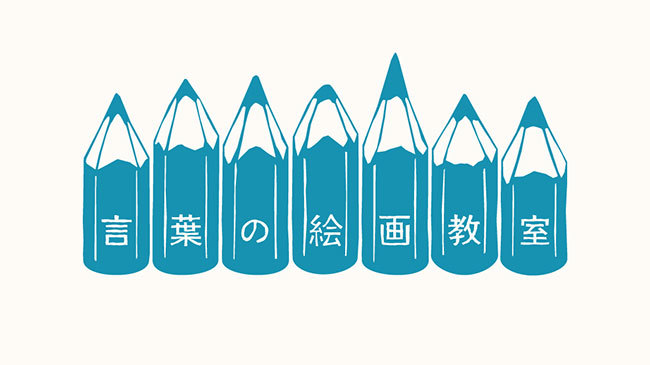Note: This website was automatically translated, so some terms or nuances may not be completely accurate.
Sharpen Your Insight! The Language Painting Class

Toru Oyama
Painting with words?

Now, looking at this photo, can you tell what's happening? On the table are concrete blocks, cloth, bottles, and bananas. People surround it. Most would probably say, "They're all drawing the motif together," right? Yes, that's correct. Everyone is drawing.

Peering at the easels of those around them, something seems off. Huh? They aren't painting. They're writing on something resembling manuscript paper. It feels more like they're writing an essay, doesn't it?
This painting class isn't just any painting class (If you thought our Active Learning Research Lab wouldn't just run a regular painting class, you're sharp).

This workshop is called the "Word Painting Class." It involves describing the motif in front of you not with paint, but solely with words.
The Word Painting Class is a slightly unusual painting class conceived by an active copywriter. Tetsu Oyama from our institute will introduce it.
Everyone sees the same thing, yet everyone sees something different.
Participants are given the workshop's original 200-character manuscript paper. Within this 200-character limit, they describe the motif before them using words. The writing time is 10 minutes. After 10 minutes, each person reads aloud the text they've just written, and everyone shares it together.
So what happens?
"Everyone sees the same thing, yet everyone sees something different."
It seems obvious, but everyone writes slightly different descriptions. The most obvious difference comes from their viewing position. Since they're seated surrounding the motif, what appears closest to some is a banana, while to others it's a bottle. This naturally changes their descriptions.
You'll also notice that everyone describes the object itself slightly differently. Take the banana, for example. Some describe it simply as "banana," using just one word. Others specify "one banana," stating the number. Some describe its size. Some try to describe it using precise units. Others describe it relative to a bottle. Some rely on common knowledge, saying things like "normal size." Furthermore, everyone conveys what they want to communicate based on the parts they can see—color, blemishes, the state of the bunch, and so on.
Even for a single banana, the ways to describe it are infinite. Add in cloth, bottles, blocks, and more, and it's impossible for anyone to use exactly the same 200-character description. This makes you realize how completely different people's perceptions can be.
How you see it is how you describe it
In our workshop, we conduct a total of three rounds of verbal painting classes. After the first round, the difference in perspectives becomes immediately apparent. Everyone sees the same thing, yet everyone sees it differently. The words chosen are different, so the way they are conveyed is different.
Then, in the next round, we change the writing style or motif and paint with words again. Unlike the first round, here we gradually become aware of the bias in our own perspective.
Even after hearing others' word paintings in the previous round and thinking, "Ah, so that's another perspective!", painting with a new viewpoint is surprisingly difficult. You realize you've unconsciously clung to a certain way of seeing things.
The third time, instead of visible motifs like bananas or bottles, we treat the "words" themselves as motifs – formless concepts like "big" or "right" that can only be depicted through language.
For example, with the motif "big," approaches vary widely: some try to convey physical size without using the word "big," depicting things like "the universe" or "a blue whale," while others express it through evocative concepts like "a father's back" or "a child's future." A key feature is that by depicting concepts rather than objects, the resulting word paintings more distinctly reflect each person's unique perspective.
Precisely because it involves painting with words, it can express everything from tangible objects to intangible abstract concepts like events, allowing for a broad range of perspectives.
Developing a Program Centered on "Words"
The Word Painting Class is a program developed by two copywriters. The original impetus was the idea of creating an educational program that focused more on words themselves, rather than design, and we brainstormed various ideas centered around the theme of "words."
Among these ideas, we sensed a hint for a new workshop in the common sentiment that "many people feel they are bad at drawing." While a painting class is naturally a place people go wanting to improve their drawing skills, we wondered: what if we replaced the "painting" part with "words"? Couldn't this allow more people to experience what one gains in a painting class? And so, this program was born.
When we tested it, we discovered that while it differs from what you learn in a painting class, using words we're all familiar with allows anyone to easily step into the realm of expression.
Can everyone write a piece of writing immediately? Some might wonder. In the Word Painting Class, we impose a limit of "200 characters in 10 minutes." We've held the Word Painting Class several times now, and so far, not a single person has been unable to write anything in 10 minutes. Almost everyone manages to write a 200-character piece within 10 minutes.
This is because writing words is an overwhelmingly more familiar skill than drawing pictures. By placing "words" within the existing framework of a painting class, we were able to create an entirely new, and somewhat mysterious, educational program.
"Perceptive power" is about defining your starting point
While people can write sentences, whether they can write from various perspectives is another matter entirely. Seeing things from every possible viewpoint requires considerable training. The Word Painting Class is designed to provide that realization and serve as practice for it.
The ability to see things from multiple perspectives is called "perspective-taking." Cultivating your own perspective-taking skills and understanding and experiencing that others see things differently from you – that is the major purpose of the Words Painting Class.
When is insightfulness necessary? When facing a problem, having multiple perspectives offers the advantage of deriving more solutions.
When formulating questions, perceptiveness also broadens the scope of inquiry—identifying where the problem lies or where to frame the problem effectively. Expanding the possible starting points directly widens the range of ideas.
If you're not accustomed to holding multiple perspectives alone, you can leverage others' strengths to cultivate diverse viewpoints as a team. Implementing a Word Painting Workshop as an icebreaker during team sessions can reveal others' habitual ways of focusing.
"Ah, so that's how the leader sees things," or "She has a unique way of looking at things." Conducting a word painting workshop before tackling actual projects or problem-solving helps you understand the direction of each team member's perspective. This allows you to grasp the thought process behind why a particular idea or solution emerged from that person, which has proven beneficial for team building.
To those who blurt out, "I'm not good at drawing"
Describe the motif in front of you using only words. After drawing, when everyone shares their word paintings, you realize that even though you're looking at the same thing, everyone sees it differently. Differences in perception are also differences in how we communicate. Since the words chosen differ, so does the way they're conveyed. With a few simple tips, you can not only experience these differences in perspective firsthand but also recognize what kind of viewpoint and field of vision you and your team possess.
The Word Painting Workshop is designed to be conducted anywhere, featuring a set of drawing motifs like bottles or plaster casts, original manuscript paper, and some writing tips. It has been used not only in schools but also as part of corporate training programs for management development and new employee orientation. It is also implemented as part of the new employee training program for those assigned to Dentsu Inc.'s creative departments.
If you're interested in trying it out, please feel free to contact us via the inquiry form on the Active Learning How About This? Institute website ( http://www.konnano-dodaro.jp/contact ).
Was this article helpful?
Newsletter registration is here
We select and publish important news every day
For inquiries about this article
Back Numbers
Author

Toru Oyama
Dentsu Inc. B Team / Active Learning "What About This?" Research Institute. Leveraging advertising creative skills honed as a copywriter, currently engaged in diverse and enjoyable activities including new ventures, corporate training, and workshops. Launched "PLAY FIRST," a design unit developing games and educational tools based on the concept of "starting with play." Specializes in designing play and projects by working backward from the ideal experience. Left Dentsu Inc. in March 2023.

